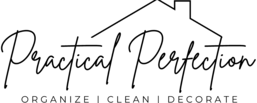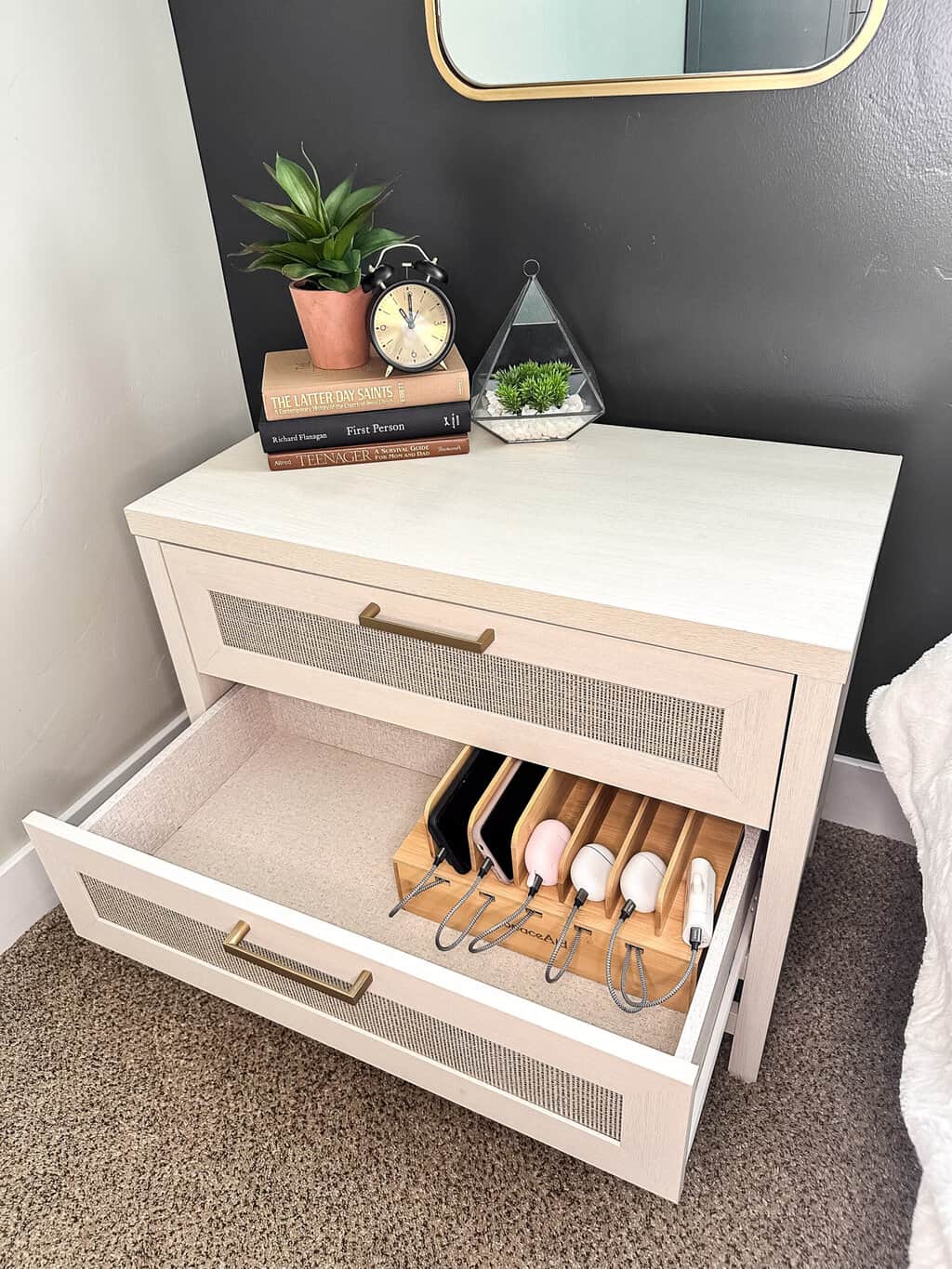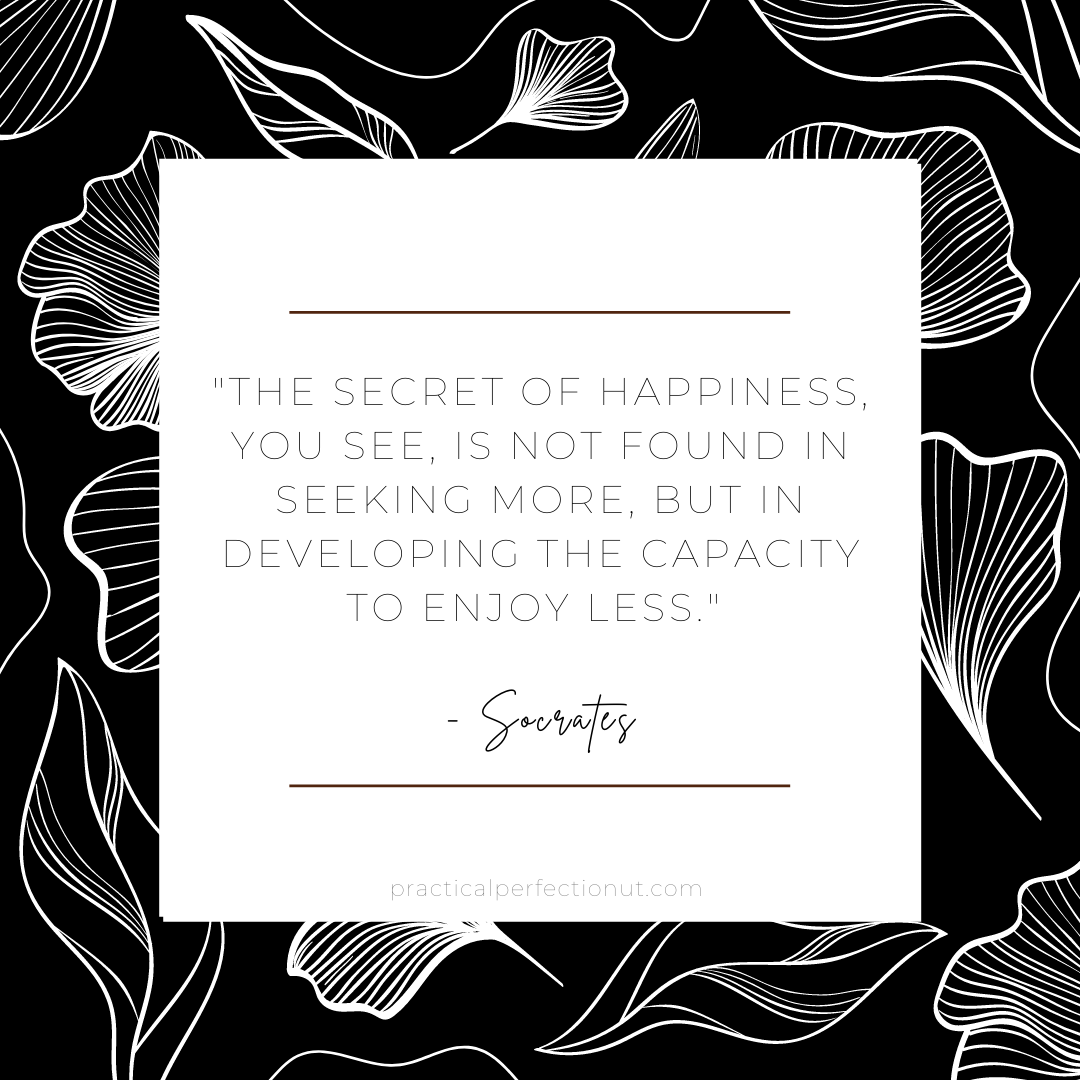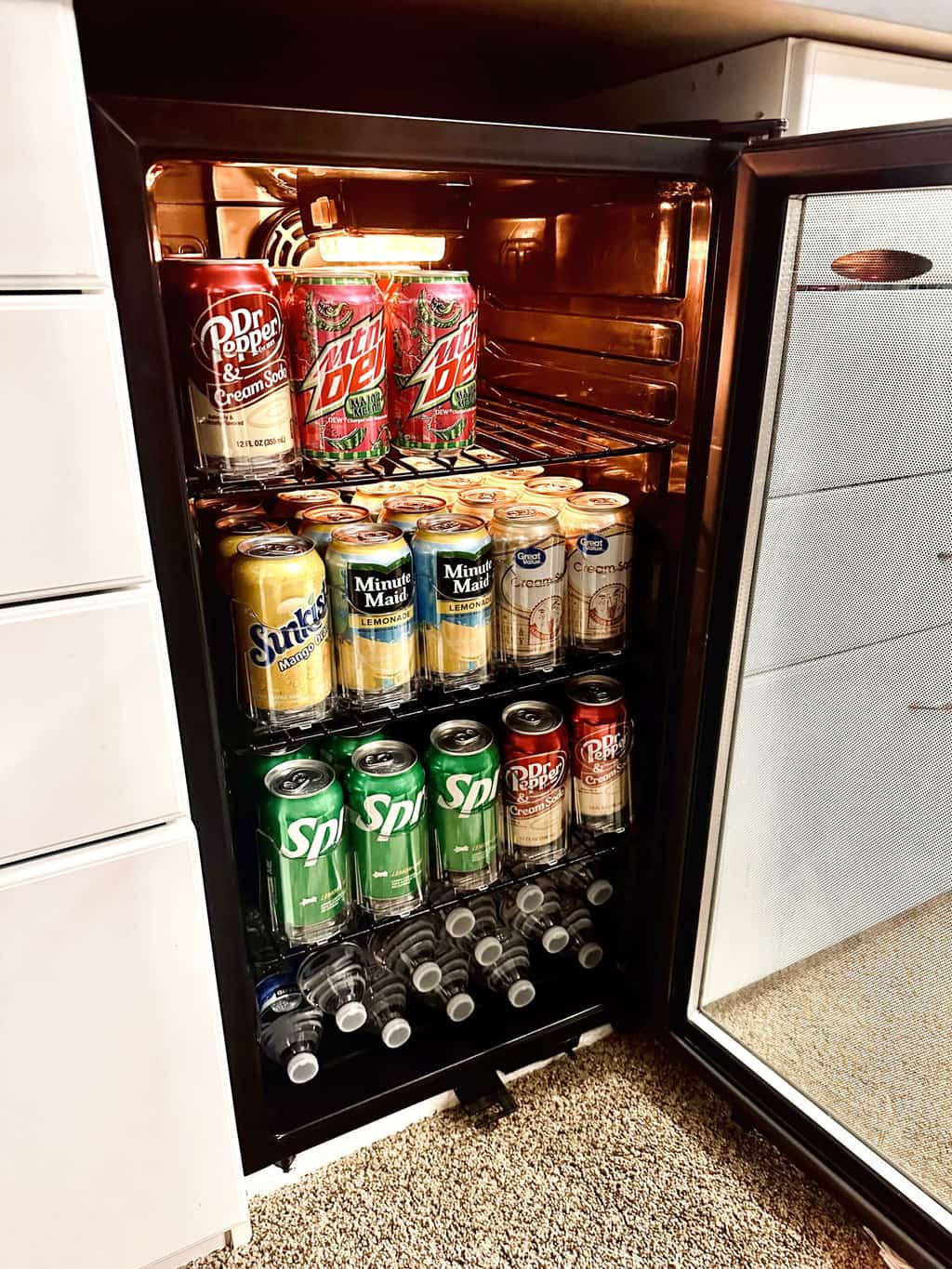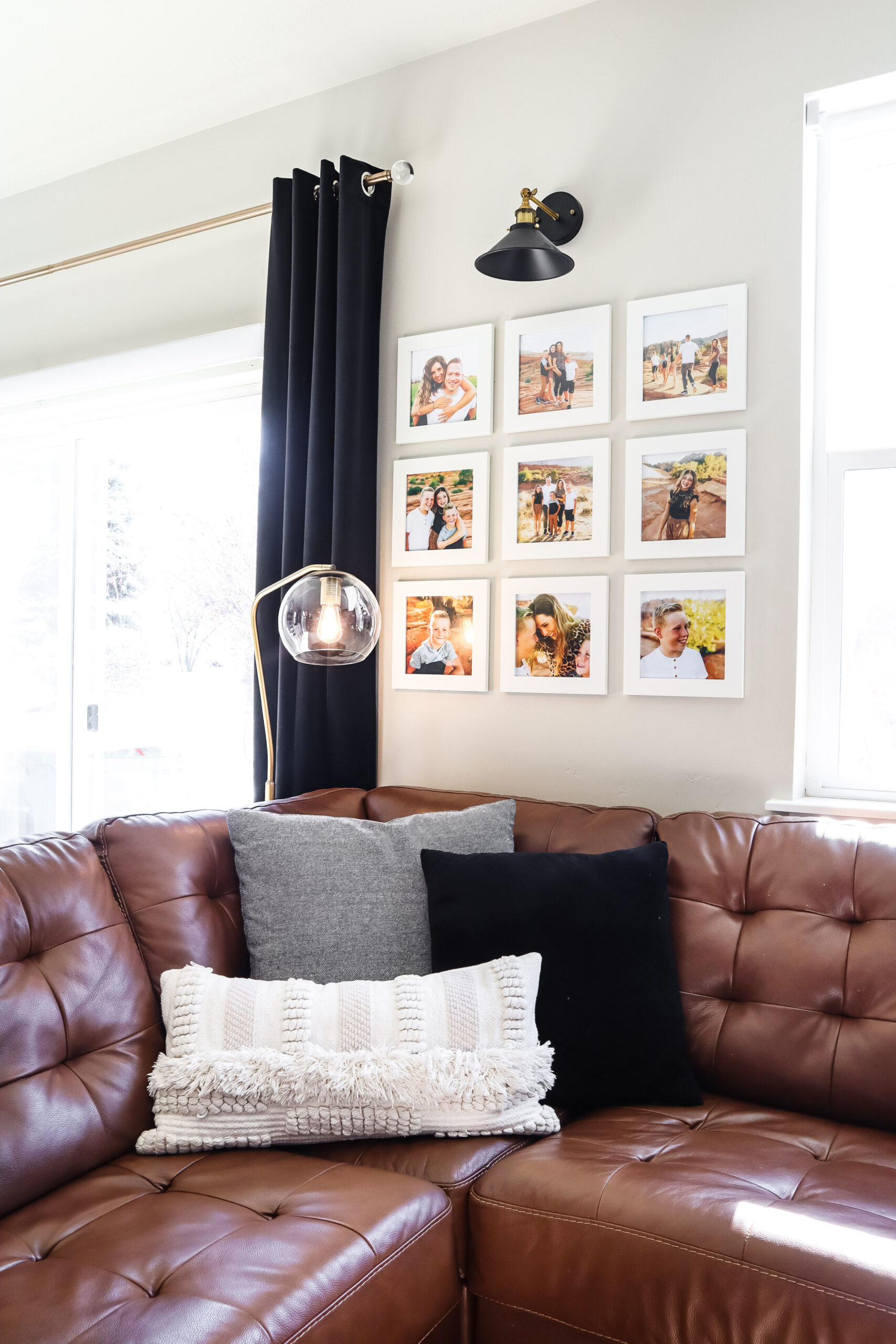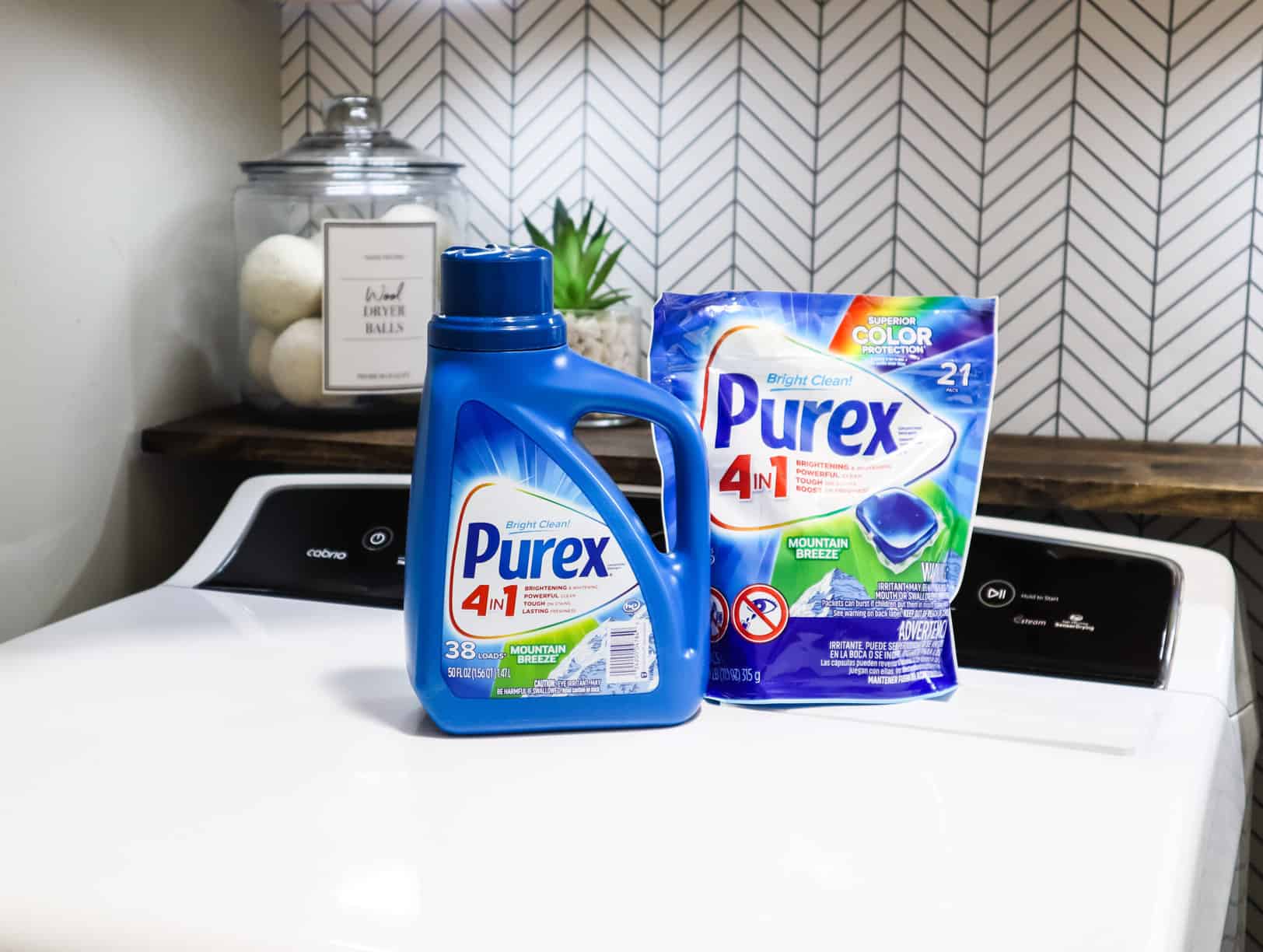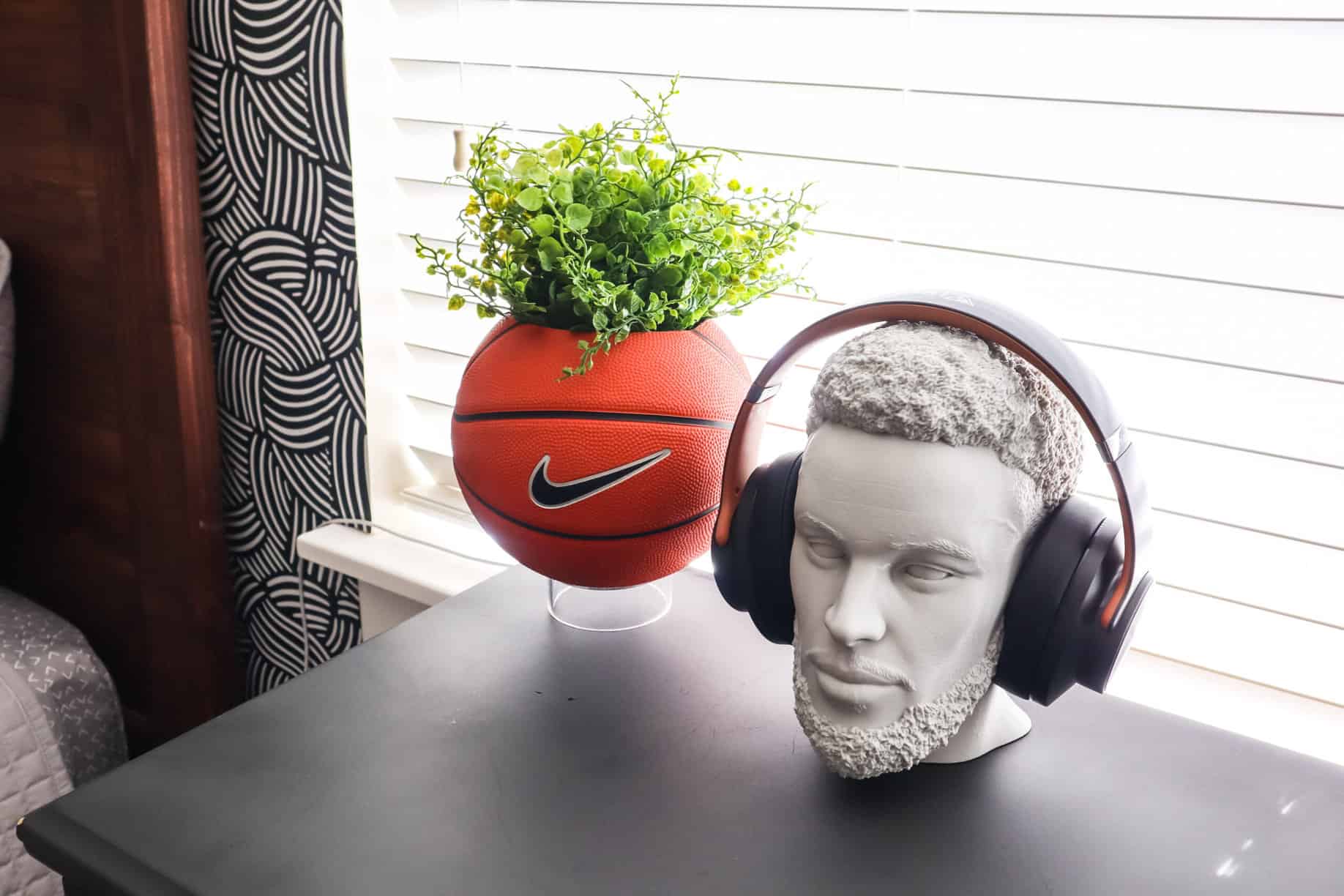The Ultimate List of Toy Organizer Ideas for Busy Parents
For parents, it’s not uncommon to feel like there are toys everywhere – bedrooms, living rooms, kitchens, and even bathrooms. With kids, it’s hard to stay on top of all their belongings and keep everything organized. Luckily, with some of my tips, tricks, and toy organizer ideas, you can declutter, categorize, and organize your toys, making your life as a busy parent a little bit easier.

Organizing Kids’ Toys: Where to Start
Getting your toys organized can be an exhausting task. How do you tackle such a large task of organizing and storing toys, art supplies, stuffed animals, and more?
Before you get started, consider involving your child in the process. Not only will this teach them valuable organizational skills, but it will also make them more likely to maintain the system since they helped create it.
As you begin the toy organization process, make a plan. If you, like many other parents, have a lot of kids’ toys throughout your home, take it one room at a time!
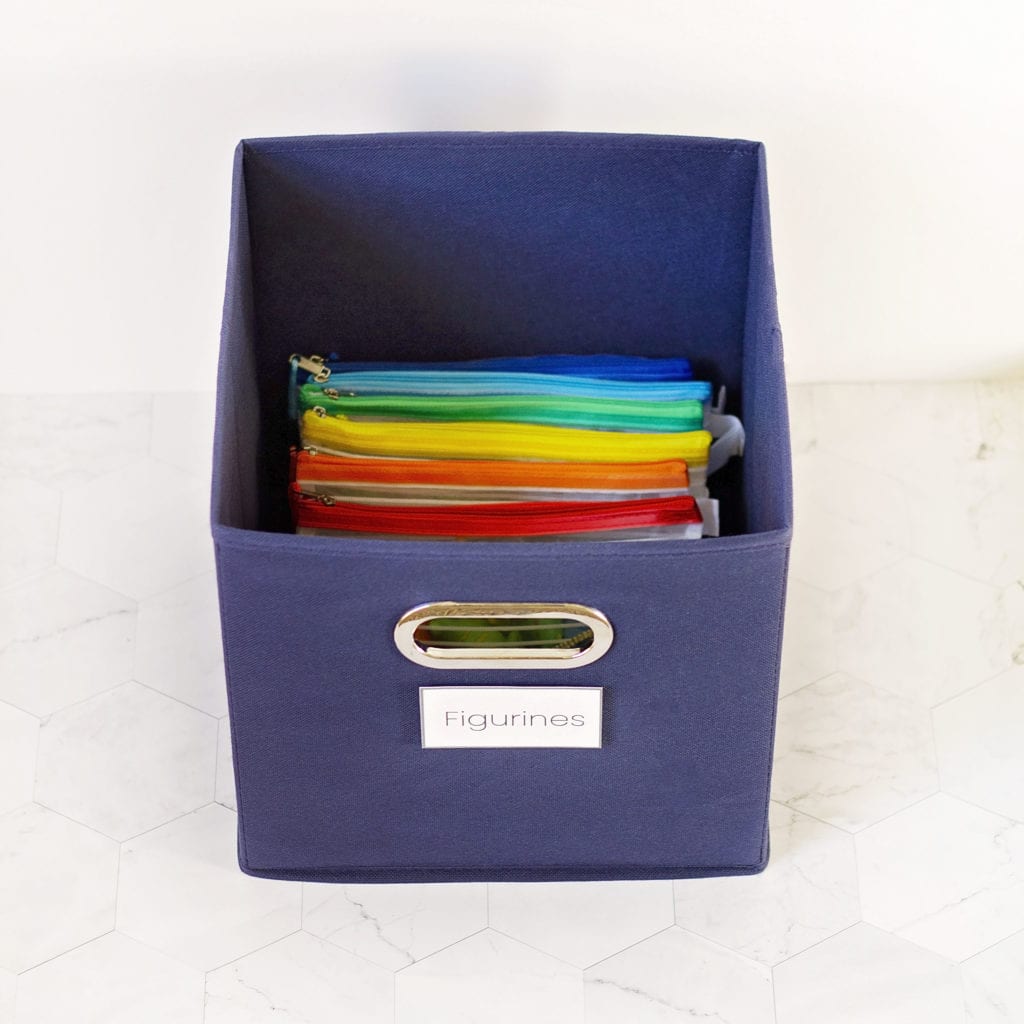
Are there toys in your kids’ room? Start there. Are there other toys in a dedicated playroom? Tackle that next. What about bath toys? You can do that on a separate day.
If you don’t keep toys in the kids’ bedroom or in any other room, you still don’t have to do the playroom all in one day. Take it slow and go methodically through your toy storage so no one gets overwhelmed. Even though it can be tempting to do it all at once and just get it over with, it can be exhausting.
So don’t worry about letting the project take a few weeks!
TOOLS YOU’LL NEED
Decluttering Your Toys
As with any organizing project, the first step in organizing toys is to declutter. It’s easy for kids’ toys to accumulate over time and leave you with cluttered rooms.
And if you’re anything like me, you probably feel like you have too many toys in your house anyway! So this is a good chance to toss toys and clear out some space. This will keep the toy collection manageable and ensure that your child’s play area remains neat and tidy.
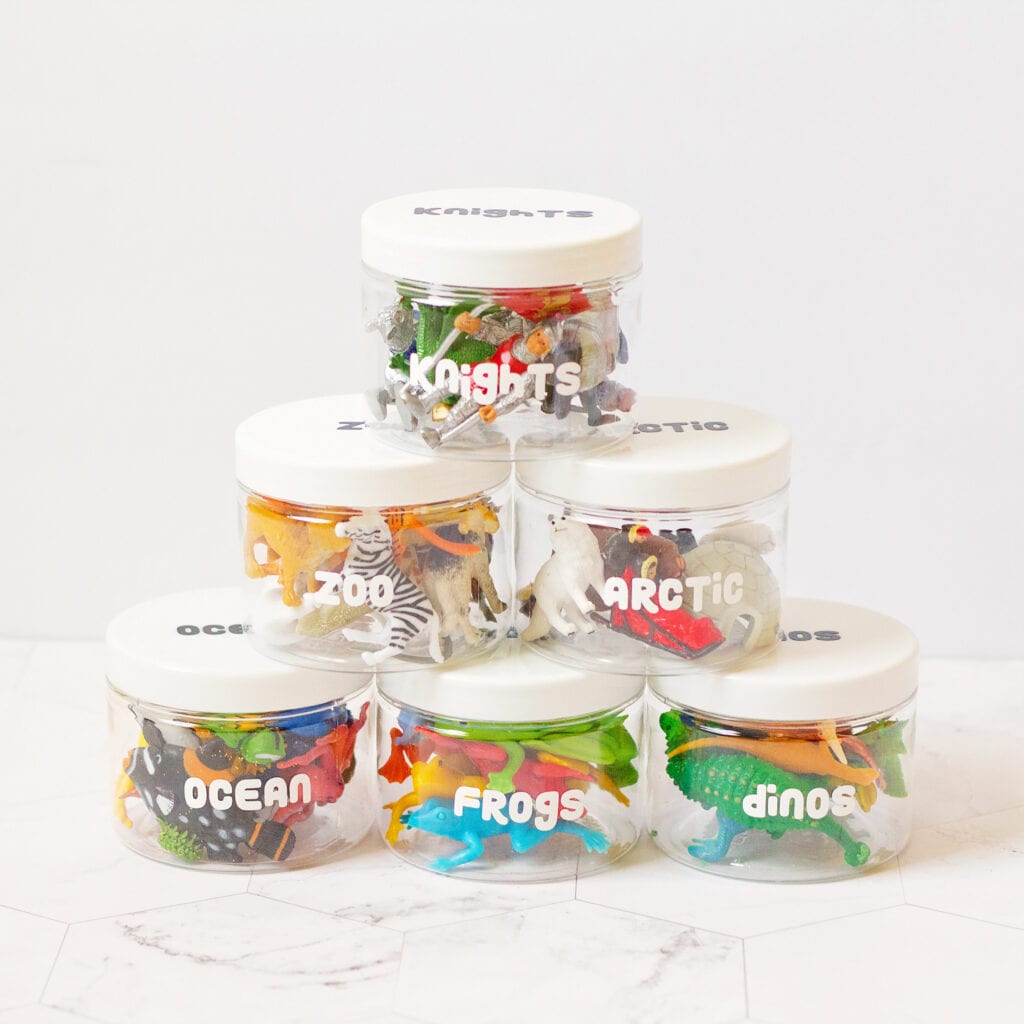
How to Declutter All That Toy Clutter
Make three bags as you declutter your toy storage. Have a “keep” bag for your kids’ favorite toys, a “throw” bag for things you’re getting rid of, and a “donate” bag for items that are still in good shape but your kids no longer play with.
Start by pulling out toys that are broken or missing pieces. If they are not fixable or replaceable (or you don’t want to deal with that), then throw them out.
If toys haven’t been played within the last six months, consider how likely it is that your child will play with them again. Toys that no longer interest your child can be donated to charities, sold at a yard sale, or given away to younger relatives. You could also donate dress-up clothes that no longer fit your children. This not only clears up space in your home but also puts the toys to good use elsewhere.

Remember that decluttering is a continuous process. As new toys come in, ensure older ones are phased out regularly to maintain balance. For each new toy your child gets, get rid of an old toy.
Set a regular schedule, maybe once every few months, to revisit and declutter your child’s toys. Advance planning and a bit of discipline will go a long way in maintaining a clutter-free toy storage!
TOOLS YOU’LL NEED
Separate and Organize Toys in Categories
After decluttering, separate your toys into categories. This initial sorting of all the toys in your house will give you a clear idea of what you’re dealing with and help you determine the best storage solutions for each category.
Here are some examples of how to break down your toy storage into categories:
- Educational Toys: These include puzzles, science kits, board games, flashcards, and books. They serve an educational purpose and can often be stored together.
- Action Figures and Dolls: If your child plays with action figures or dolls, these should be grouped together. This group also includes associated items like doll clothes and accessories as well as toy cars.
- Dress-Up Clothes: Anything your kids love to dress in, like dresses or hats or even little toy swords and shields. Anything that they can put on and wear as they play.
- Arts and Crafts: All craft materials such as crayons, paints, paper, glue, and scissors can be sorted under this category.
- Outdoor Toys: Everything that your child uses outdoors, like balls, skipping ropes, water guns, or sand toys.
- Building Blocks and LEGO: These can be grouped together due to their similar nature and usage.
- Stuffed Animals: These can be grouped together in a separate category.
- Sensory Items: These are toys that stimulate a child’s senses and can include items such as fidget spinners, sensory balls, Play-Doh, musical instruments, light-up toys, and more.
You could have a lot more categories as you get your toys organized or you could have less! It really just depends on how many toys you have!
Within those categories, you might want to separate out big toys and smaller toys. Some bigger toys won’t fit in the same storage bins as action figures, so you’ll need different toy storage options for those.
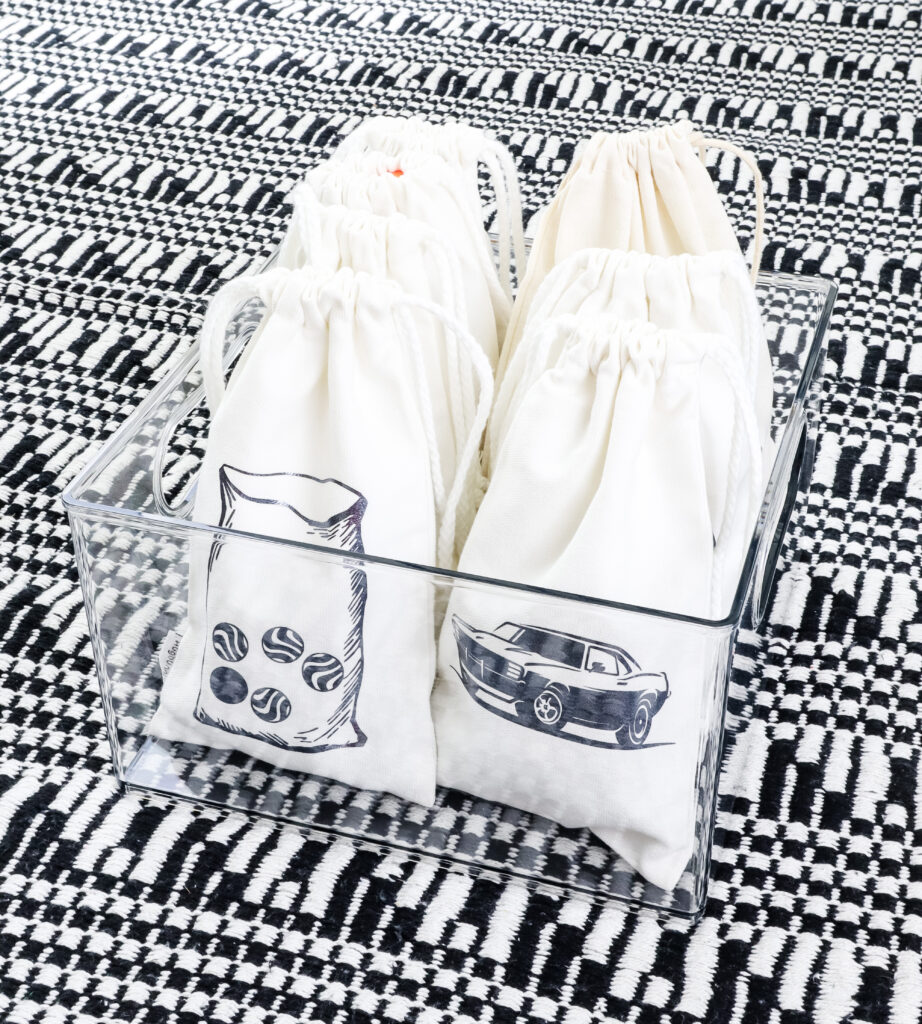
Creating categories helps with organizing because it allows you to have a clearer vision of what types of toys you have. Plus, it makes it easier for your child to find what they are looking for when they want to play.
Dividing toys into categories also makes it easier to allocate specific storage spaces for each category, making cleaning up and maintaining order much simpler. It’s also a great way to teach your child about categorization and responsibility, as they will know where each toy goes after they’re done playing.
In the following sections, we’ll explore specific needs for each category of toys and hopefully provide some brilliant toy storage ideas for your home.
TOOLS YOU’LL NEED
Toy Organizer Ideas for Small Toys
Small toys are typically the hardest to organize. Start by finding or purchasing small clear bins with lids. You can then separate your small toys into categories using ziplock bags or smaller containers inside the larger container.
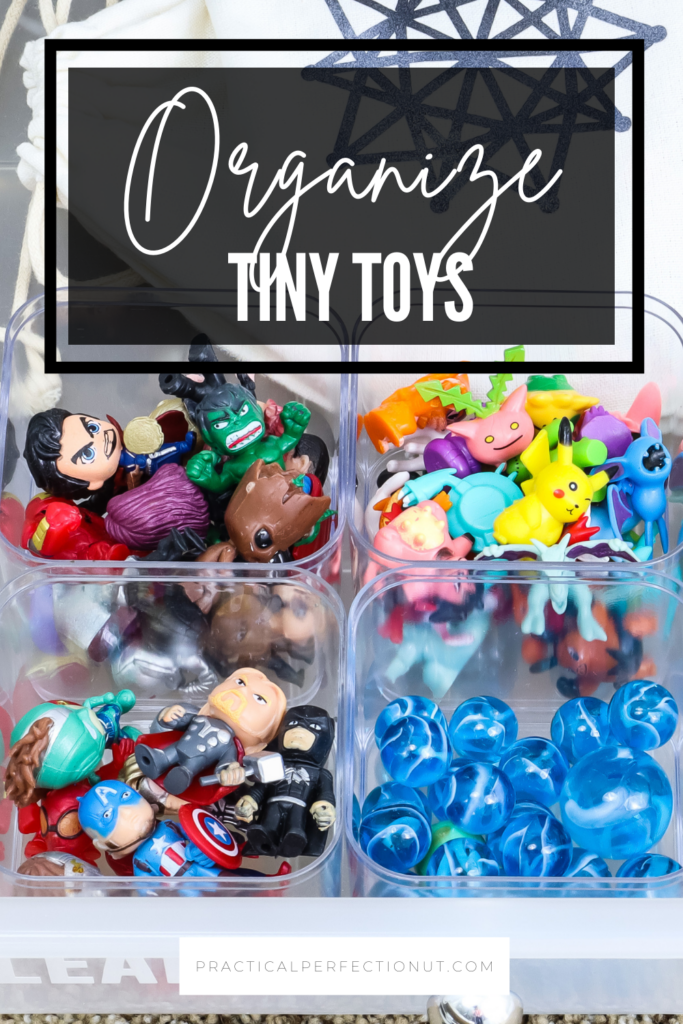
Depending on how many small toys you have, you might need several storage bins. Have one bin or bag designated for toy cars, another for action figures, another for accessories, and so on.
Additional Toy Storage Ideas for Small Toys
- Over-the-Door Hanging Organizers: These are not only for shoes! You can repurpose them to store small toys like dolls, action figures, or even art supplies. Each pocket can be designated for a different type of toy. The big advantage is that they hang vertically, making great use of otherwise wasted space.
- Magnetic Strips: Magnetic strips aren’t just for kitchen knives anymore. They can be mounted on the wall in your child’s playroom or bedroom to organize and display metal toys like toy cars and trains.
- Pegboards: Pegboards are a versatile storage solution that can be customized to fit your needs. You can hang small baskets or containers on them for storing small toys.
- Jars and Canisters: Clear jars or canisters are excellent for storing small toys like Lego blocks, puzzle pieces, or doll accessories. They can be stacked on shelves, providing visible and accessible storage.
- Stackable Plastic Drawers: These types of drawers are perfect for storing small toys. Each drawer can hold a different category of toy, and they can be stacked to save space.
- DIY PVC Pipe Shelves: For a more creative solution, you can cut pieces of PVC pipe and mount them on the wall. They are perfect for storing small stuffed animals, dolls, or action figures.
❤️ For additional ideas, check out my post on how to organize small toys.
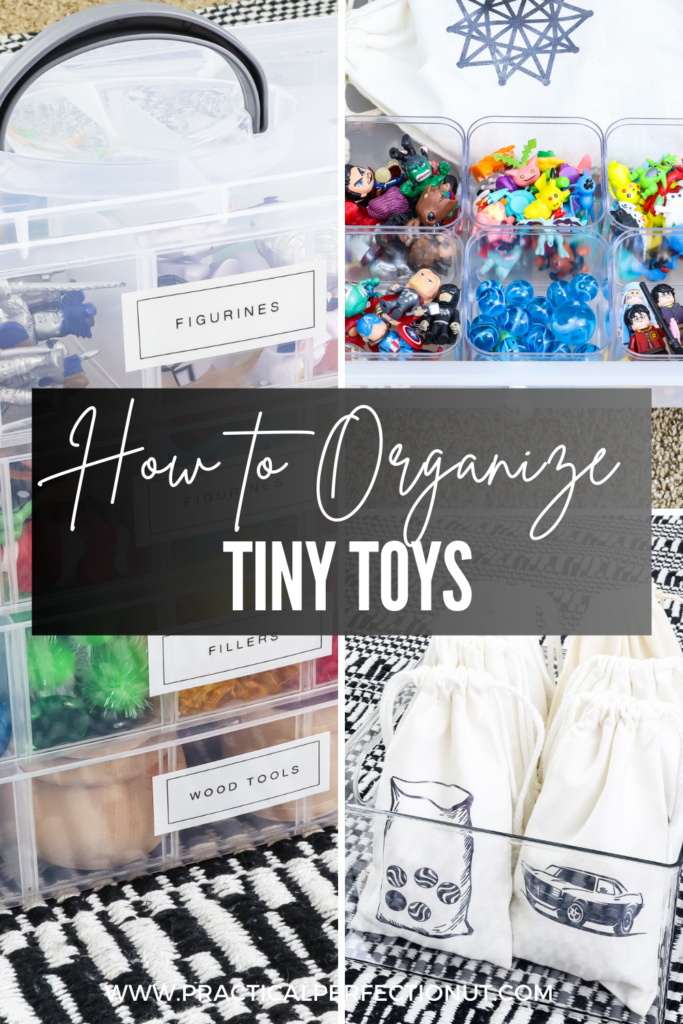
Remember, the key to good toy storage is making sure it’s easy for your child to access and put away their toys. The easier it is, the more likely they are to keep their play area tidy!
Also, labeling your containers is a great way to make sure the kids put things back where they belong. As we go on, you’ll see that labeling is a huge part of toy organization!
TOOLS YOU’LL NEED
How to Organize Arts and Crafts Supplies
Arts and crafts supplies can be organized in a variety of ways. For example, you can use plastic caddies or toolboxes with compartments for different supplies like crayons, markers, pencils, and scissors. These are portable, which makes them easy to move around as needed.
For materials like construction paper, sketchbooks, or other large and flat items, a file organizer can be an excellent storage solution. This will keep paper from getting crumpled and make it easy to find what you need.
Use your wall space!
If you have wall space, installing shelves can be a great way to store arts and crafts materials. Take advantage of that vertical space! You can use jars or baskets on the shelves to hold different supplies. Make sure these are at a level where your kids can easily reach them.
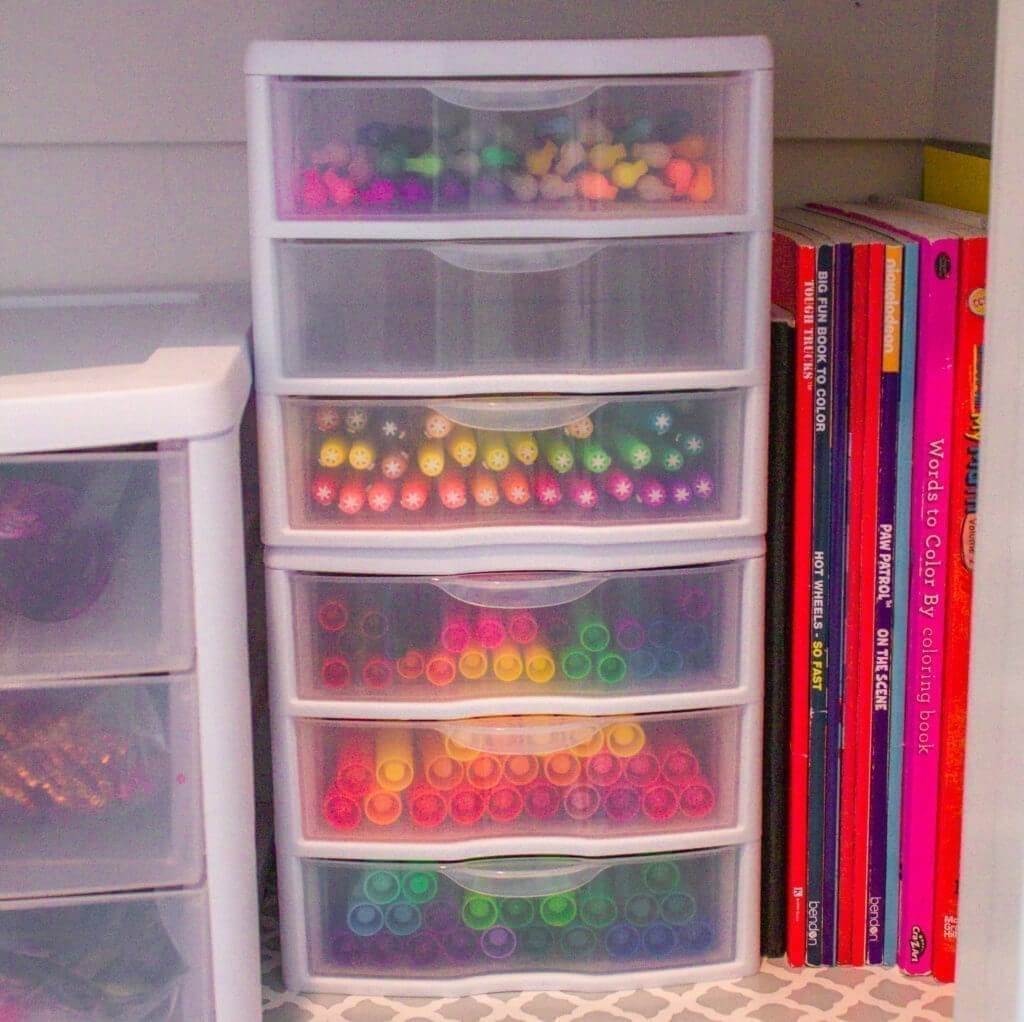
Using a pegboard with hooks allows you to hang various supplies like scissors, tape, yarn, and paintbrushes. Small buckets or baskets can be hung from hooks to hold items such as colored pencils, markers, and glue sticks.
Flat items like construction paper or stencils can be stored in clear document holders or flat baskets. You can also use clips to hang artwork or projects in progress. This system is not only functional but also visually appealing, adding a touch of creativity to the space.
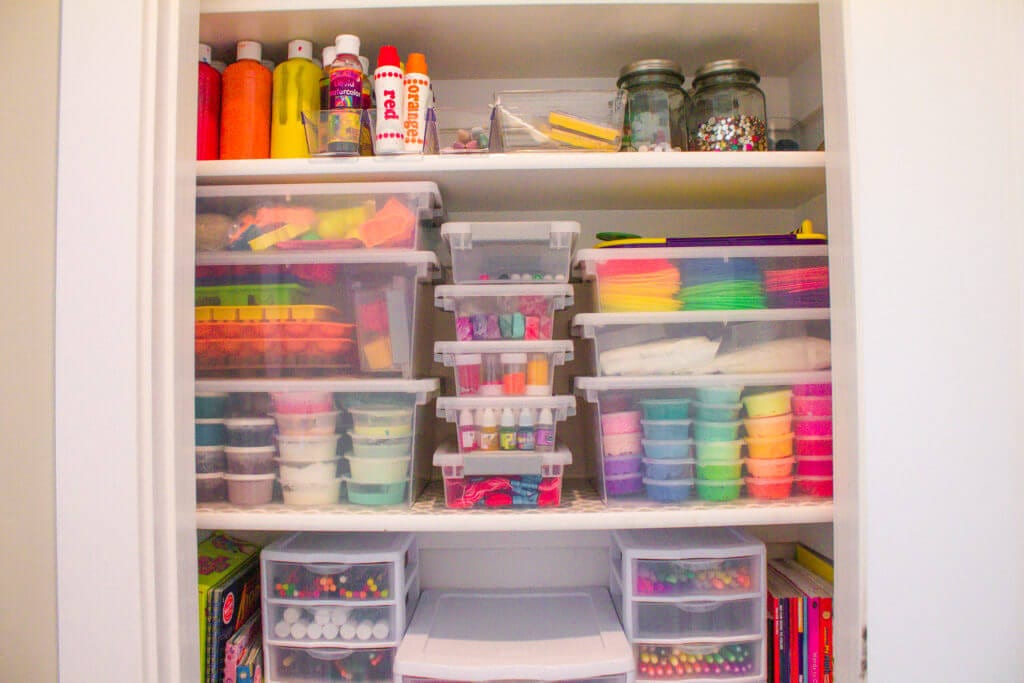
Remember to label!
Labeling is crucial in all these kids’ toy storage ideas. Make sure that each compartment, drawer, basket, or jar is clearly labeled with what it contains. This way, your kids will know where to find what they need and where to put it back when they’re done.
Remember, the goal is to keep everything accessible and visible, so your kids can easily find what they need and clean up after themselves when they’re done crafting. It’s designed to make clean-up time a bit easier for everyone.
❤️ Check out my other post for more ideas on organizing craft supplies.
TOOLS YOU’LL NEED
Toy Organizer Ideas for an Art Cart
If none of those organization ideas for arts and crafts supplies excite you, consider using a rolling cart with drawers to hold items such as markers, crayons, and construction paper.
These carts come with multiple drawers that can be used to sort and store different types of supplies. For example, one drawer could be for paints and brushes, another for glitter and glue, another for construction paper, and so on.
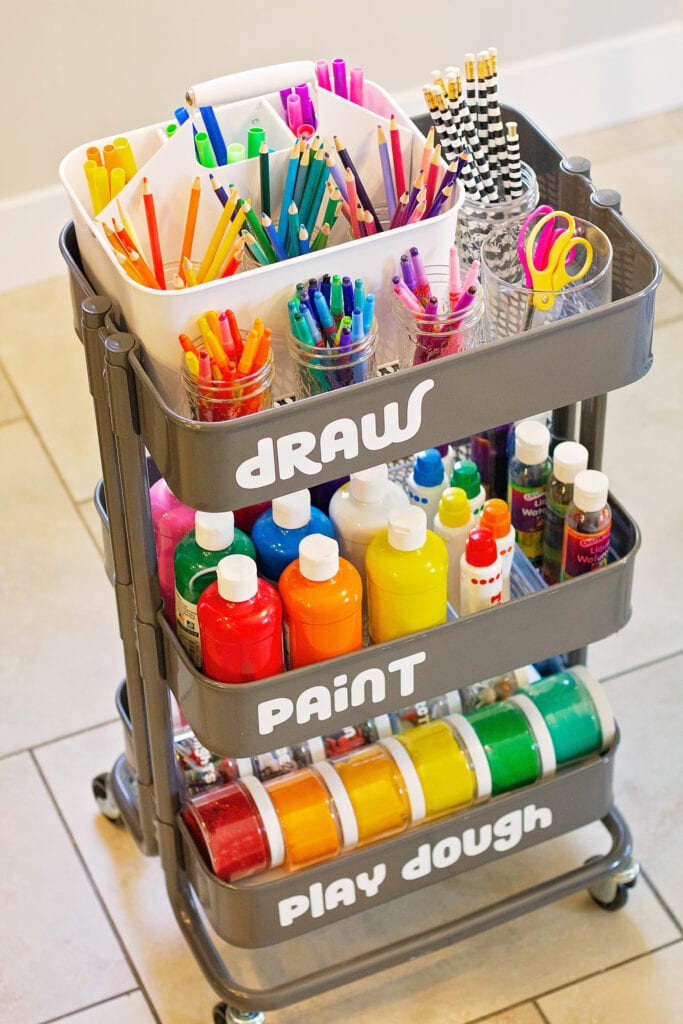
How to Make an Art Cart
Creating an art cart for kids is not only a fun project, but it’s also a practical solution for clutter-free living. First, choose a rolling cart with several compartments or drawers to separate the art supplies. Make sure the cart is sturdy and the wheels move smoothly for easy transportation.
The uppermost shelf or drawer can be used for easy access to frequently used items like crayons, colored pencils, and markers. Consider using dividers or small bins within the drawer for better organization. The next shelf can host paints, paintbrushes, and other wet materials.
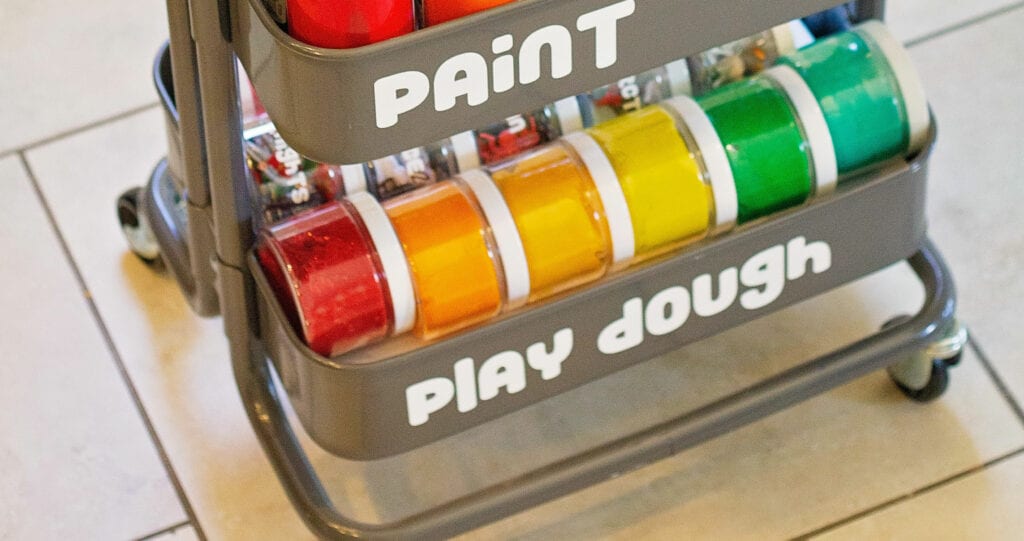
Don’t forget to add a space for paper supplies. A drawer or a vertical slot on the side of the cart can be designated for construction paper, sketchbooks, and stencils. Be mindful of size when deciding where to place these items.
The bottom shelf can be used for less frequently used items like specialty craft supplies. Think about including a small garbage bin or recycling area here for scrap paper and other waste.
Finally, consider creating a space on the cart for displaying your child’s artwork. This could be a magnetic strip, a corkboard, or a simple wire with clips. Not only does this give your child a sense of pride in their work, but it can also inspire them to create more.

Get Kids Involved
Remember to involve your child throughout the process. Let them help decide where things should go and label each compartment or drawer accordingly. This way, they will feel ownership of the cart and be more likely to maintain its organization. Plus, it’s another great opportunity for a learning and bonding experience.
If you have little kids, your art cart might have to go into hidden storage when you’re not around so they can’t get into it. But if you have older kids, letting them access the cart whenever they’d like is a great way to encourage independent play. This is one of my favorite toy organizer ideas that I’ve done to date.
❤️ Read my other post for more information on creating an art cart.
TOOLS YOU’LL NEED
Toy Storage Ideas for Sensory Bins
When it comes to sensory bin supplies, a plastic container with a lid is the best option. You’ll want to keep your sensory bin kits together so your kids can play with them all in one place.
Sensory bins often have small items or materials like sand that could get all over your playroom storage if you’re not careful. So having them in clear bins with lids can be a life-saver for any possible messes.
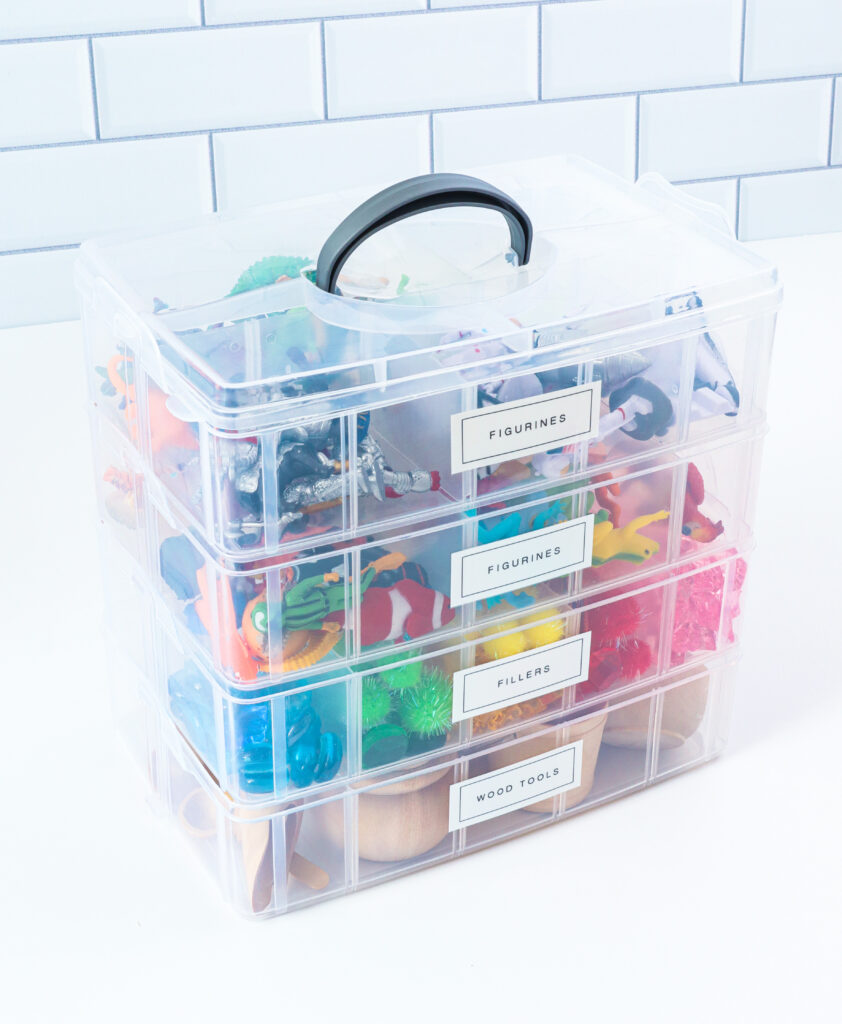
Toy Organizer ideas for Sensory Bins
Creating a dedicated storage space for sensory bins in your toy storage is vital to ensure that they are easily accessible but stay tidy. Here’s how to go about it:
Choose the Right Container
Start by selecting a suitable container for the sensory bin. This could be a plastic storage tub with a secure lid to keep the contents safe and prevent any spills. If you don’t have an air-tight container, you should be able to easily find one online or at any container store.
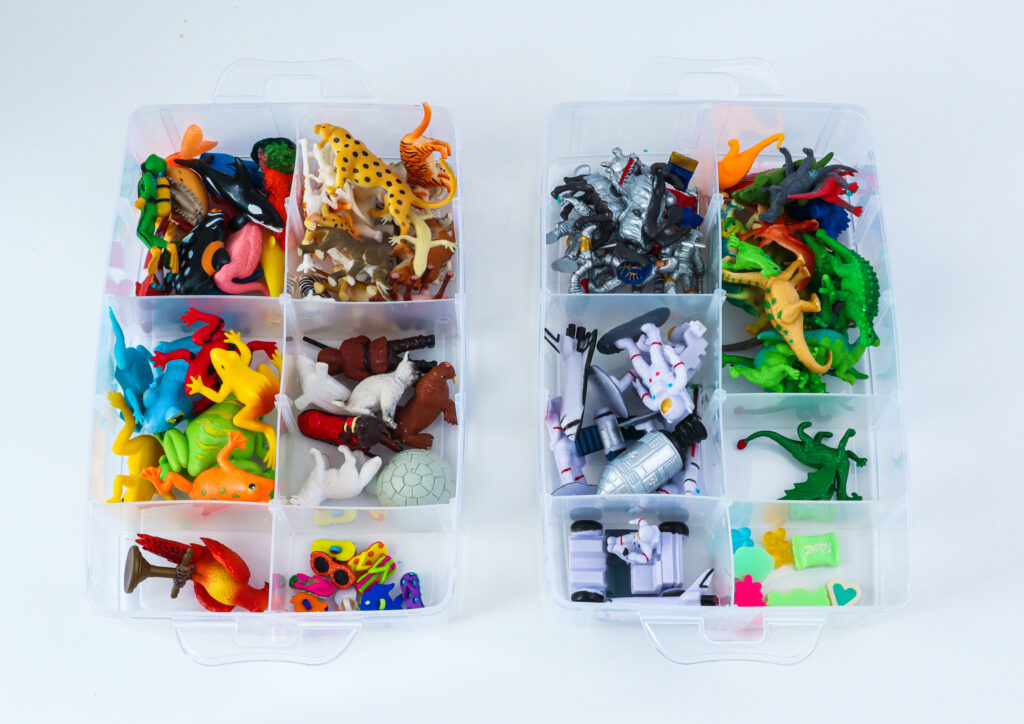
Organize Sensory Materials
Within the bin, you can use smaller containers or zip-lock bags to organize different sensory materials like sand, rice, or beans. Clear containers are ideal as they allow your child to see the contents easily.
Designated Storage Area
Choose a storage area that is easily accessible to your child but also safe and out of the way of regular household traffic. This could be a low shelf in a playroom or a dedicated corner in their bedroom.
Label Everything
As with all organizational systems, labeling is crucial. Clearly label the main sensory bin and the smaller containers inside it. This makes it easier for your child to find what they want and also helps them learn to put things back in their proper place.
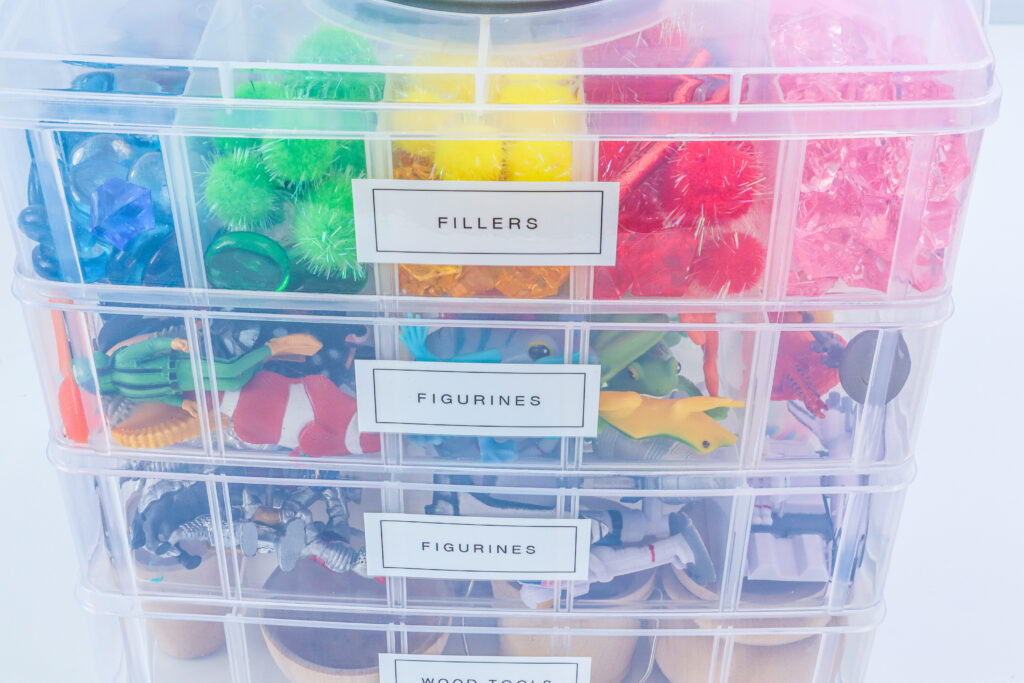
Keep it Clean and Tidy
Clean the bin regularly to ensure it remains a hygienic play area. Also, encourage your child to tidy up after they play, putting all materials back in their containers.
Remember, sensory bins provide an excellent opportunity for your child to explore and learn through their senses. Having a neat and organized storage system makes this activity an even more enjoyable and educational experience.
❤️ For more information, check out this post.
How to Organize Legos
Organizing Legos can seem like a daunting task given their small size and high count, but with a systematic approach, it can be made manageable and fun. Here are some steps to help you for find the best toy organizer idea for legos:
Use Divided Storage for toy organizer ideas
Divided storage containers are a great way to sort and organize Legos. You can separate pieces by color, size, or type. If your child has specific Lego sets, consider using these compartments to store the pieces for each set separately. Clear containers are preferable as they allow you to see what’s inside without having to open each one.
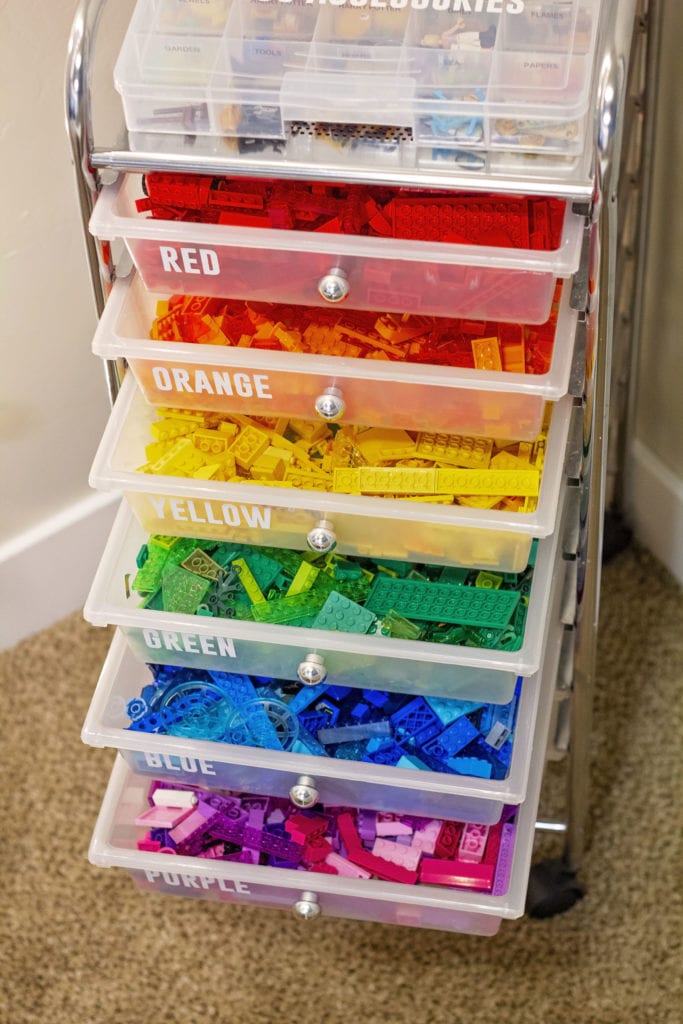
Label Everything
Once you have sorted the pieces, label each compartment clearly. This could be as simple as a color-coded sticker for color-sorted Legos, a number for Lego sets, or a written label for specific types of pieces. This not only makes it easier for your child to find the pieces they need but also encourages them to put things back in their proper place.
Use Drawstring Bags for Larger Sets
For larger Lego sets or collections, drawstring bags can be a practical storage option. They are easy to open, can hold a lot of pieces, and can be hung up or stored in larger containers, like hanging baskets, to keep everything tidy.
Designated Lego Building Area
If you have the floor space, consider setting up a designated Lego building area. This could be a table with storage bins underneath, or a portable tray that can be moved around. Having a specific area for Lego play can help contain the mess and make clean-up easier.
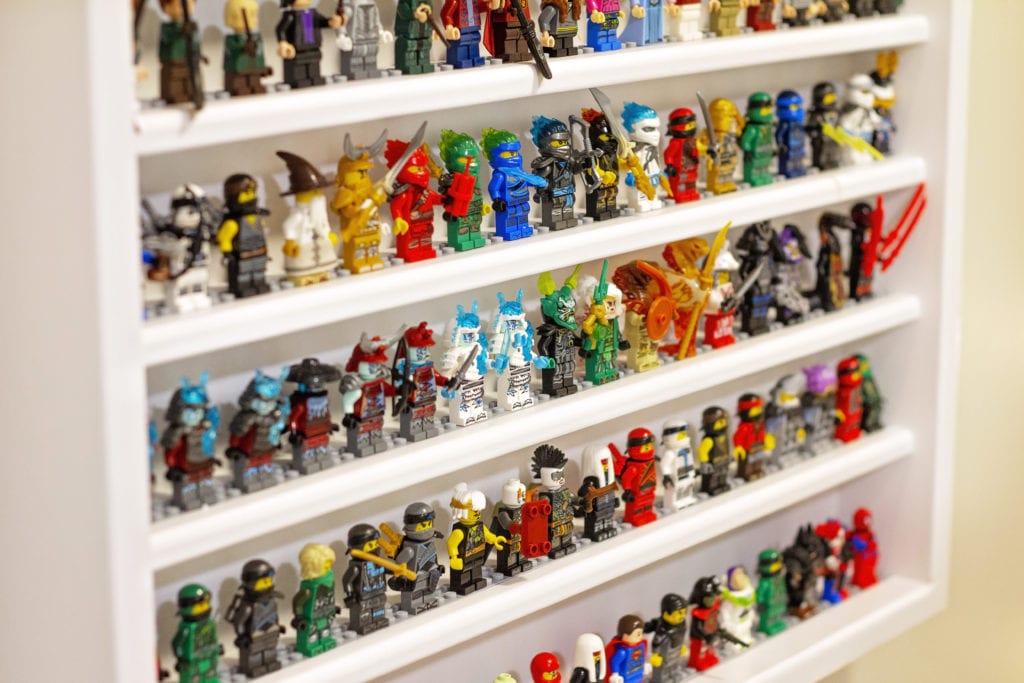
Regular Clean-Up
Encourage regular clean-up sessions where all Legos are put back in their designated places. Make this a fun activity by turning it into a game or challenge.
By employing these strategies, you can keep your Lego collection well-organized and easily accessible, making playtime more enjoyable and cleanup a breeze.
❤️ For more tips on Lego organization, check out this post on how to organize Legos.
TOOLS YOU’LL NEED
your shortcode here
Organization Ideas for Board and Card Games
No post about the best toy organizer ideas would forget how to organize and store games! If you have lots of games and want to organize them within your existing toy storage, here’s how.
Choosing the Right Storage Solution
When it comes to organizing board and card games, choosing the right storage solution is paramount. This could be a bookshelf in the playroom or a dedicated cabinet in the living room. Make sure the storage solution is sturdy and spacious enough to accommodate all games without piling them up.
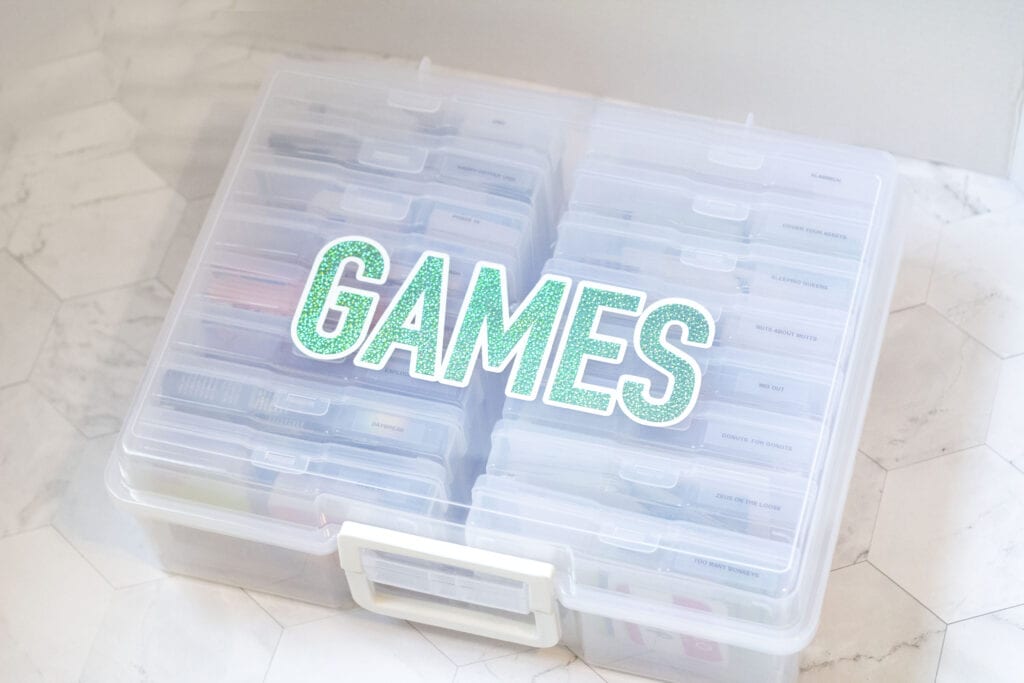
Categorizing the Games
Categorize the games based on their type, frequency of use, or age appropriateness. This way, your child can easily find the game they’re looking for, and it makes tidying up more straightforward.
Storing Card Games
Card games often come in boxes that wear and tear over time. Consider transferring the cards into durable plastic containers or card holders. Remember to label each container with the name of the game.
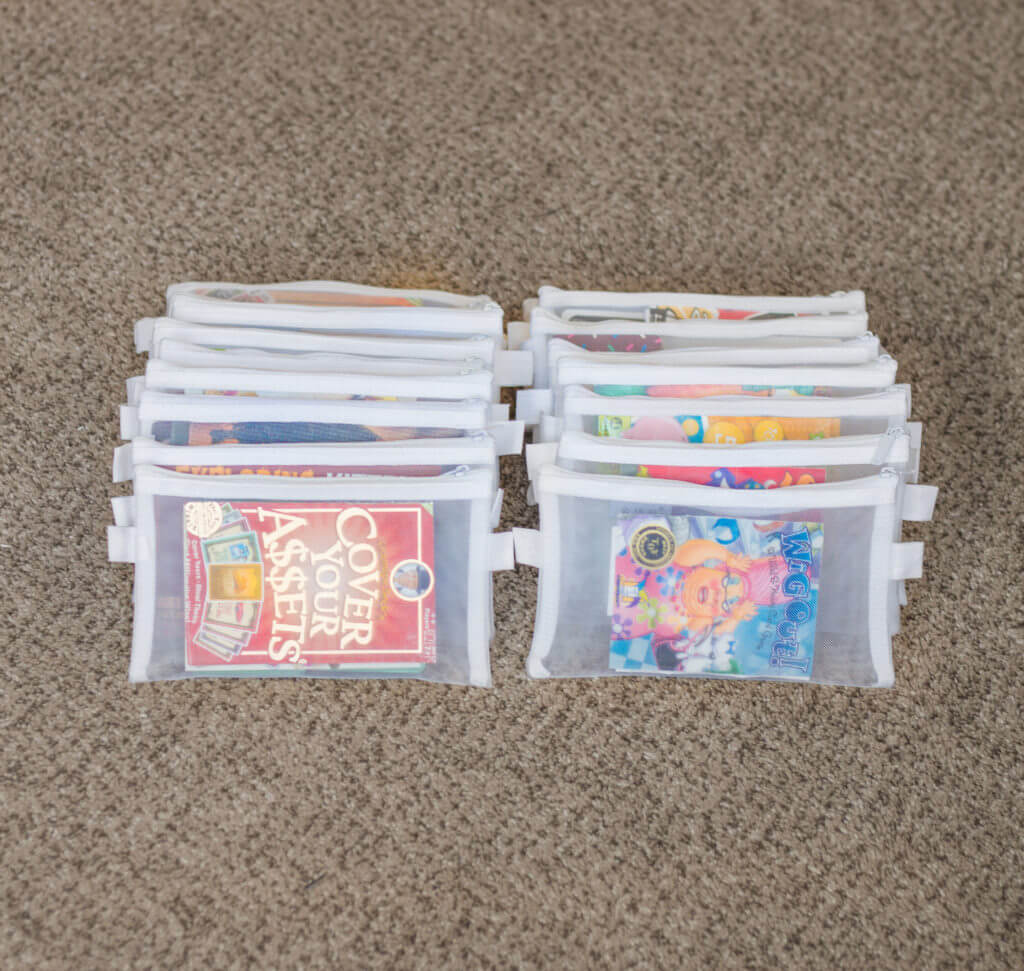
One of my favorite tips for when you organize kids’ toys is to not be afraid to throw out the container the toy or game came in. If it’s a clunky size or not very durable, get a new container for it!
Using Vertical Space
Board games can be bulky and can take up more space than other toys, but they typically have flat, square-shaped boxes that stack well. Make use of vertical space by stacking board games on their sides, like when you store books, to maximize space and make game titles easy to read.
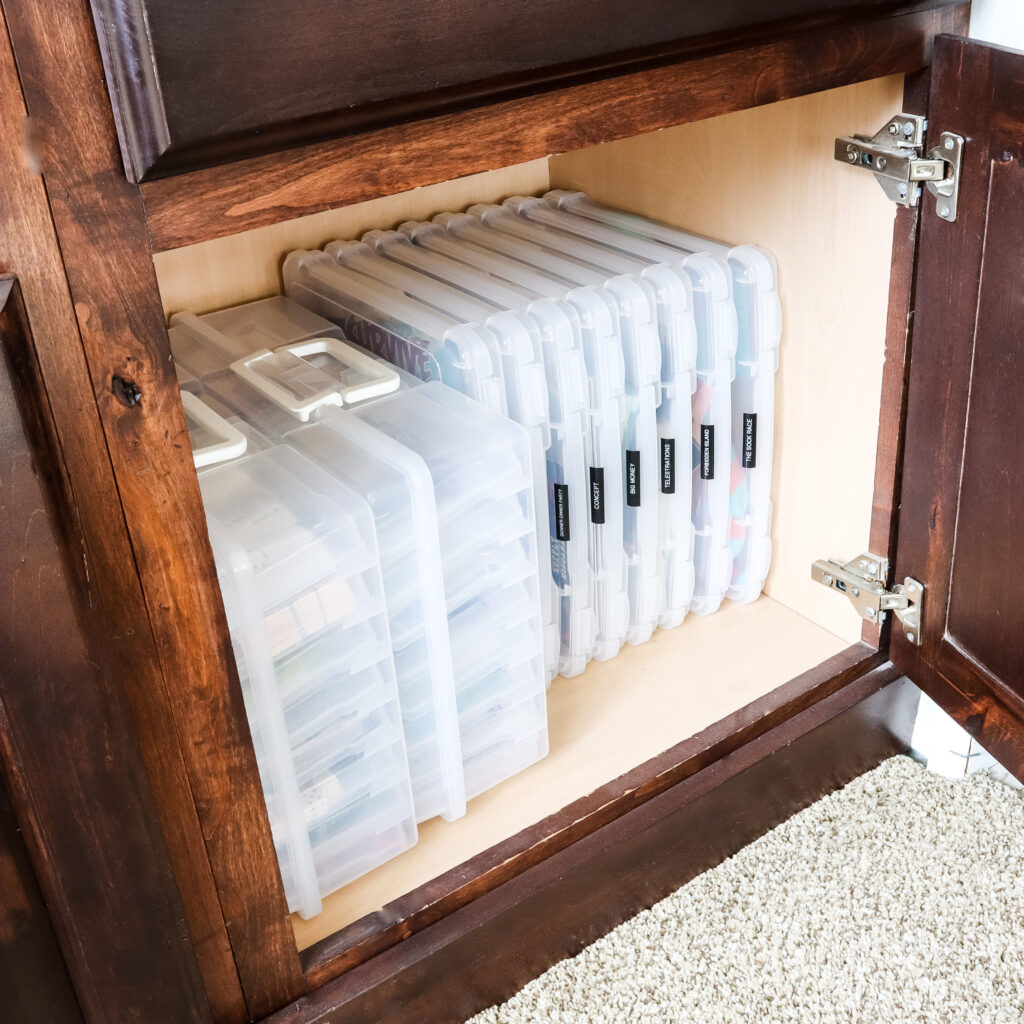
Regular Maintenance
Make sure to check the games regularly for missing pieces. Use zip-lock bags or small containers to store game pieces that get separated from their box.
Remember, the aim is to keep your games in good condition and organized in a way that makes them easy to find and put away. This not only prolongs the life of your games but also makes game time more enjoyable.
❤️ For more tips on organizing board and card games, read this post.
TOOLS YOU’LL NEED
your shortcode here
Toy Storage Solutions for Puzzles
Puzzles, with their myriad of pieces, also require a systematic approach to storage. Here are a few strategies to keep your puzzles organized and easily accessible:
Keeping Puzzles in Your Toy Storage
For smaller puzzles, consider using zip-lock bags. They are a cost-effective and space-efficient way to store individual puzzles. Remember to label each bag with the puzzle name or a brief description for easy identification.
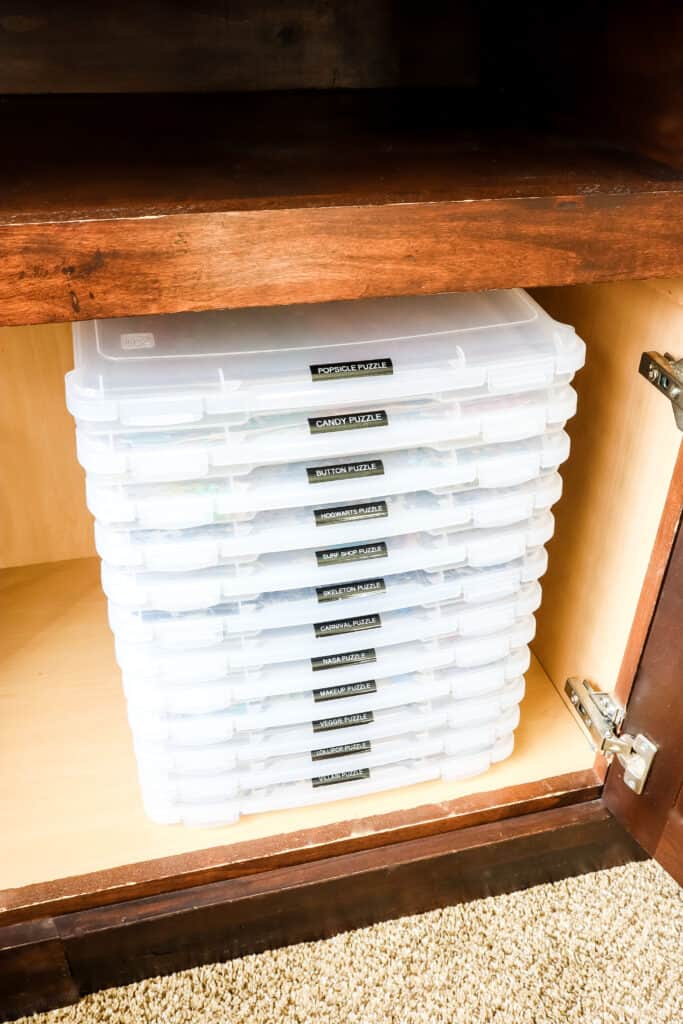
Consider investing in a puzzle storage rack. These racks come in various sizes and are designed to hold puzzles of different sizes, keeping them flat, organized, and easily accessible. This is an especially good option for larger puzzles.
For larger puzzles, consider portfolio storage solutions. This involves placing completed puzzles between sheets of cardboard or foam board and storing them flat in a portfolio case or under a bed. This keeps the puzzles safe and prevents them from taking up too much space.
If you prefer to keep puzzles in their original boxes, store them vertically like books on a shelf. This makes it easier to see the puzzle images and access the box you want without disrupting others.
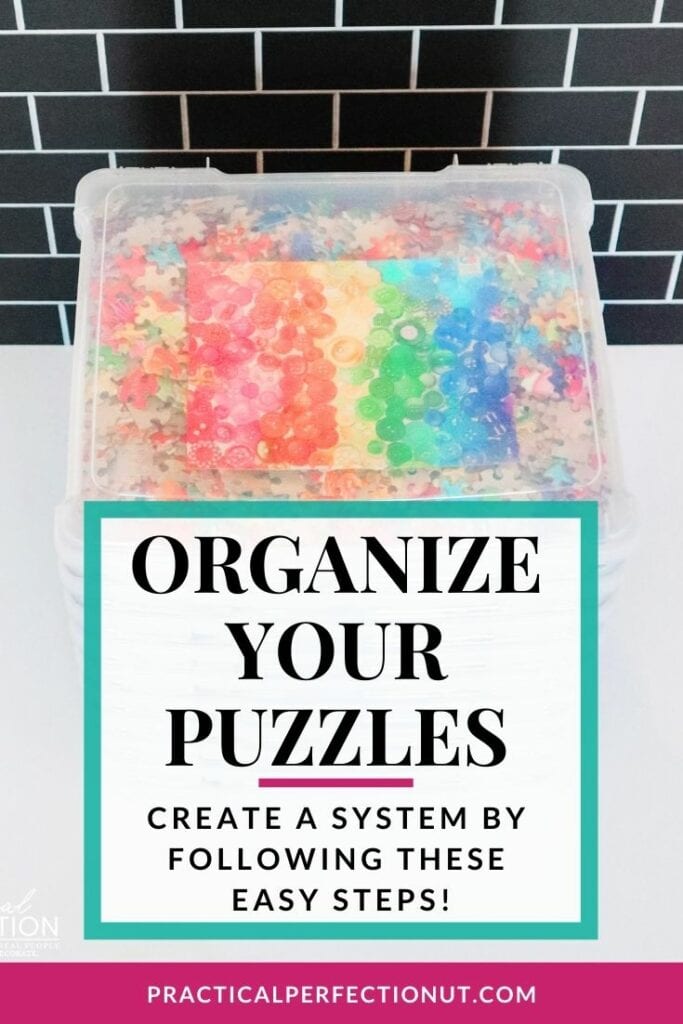
As Always, Maintain Your Puzzles in Toy Storage!
Regularly check puzzles for missing pieces. Consider storing completed puzzles separately from those that are missing pieces, so you know at a glance which ones are ready to be worked on.
Remember, the goal is to keep your puzzles in good condition and stored in a way that makes them easy to find and use. These strategies can help ensure your puzzles are always ready for the next puzzling session.
❤️ For more tips on storing puzzles, read this post.
TOOLS YOU’LL NEED
Other Toy Organization Ideas to Help You Store Toys
To save money, it’s always good to look around your house for bins and containers you can use for your toy storage. You don’t have to spend tons of money to store toys if you can repurpose existing containers or have any built-in storage options.
However, you might need to purchase new containers to implement some of these toy storage ideas. If that’s the case, here are a few ideas of what to look for in storage containers.
Toy storage bins come in various sizes and can be stacked or placed on a shelf. They’re great for storing larger toys or a group of toys that go together. Choose clear bins for visibility, or decorative ones to match your room’s decor.
Make sure you find items that allow you to store lots of toys and can fit in the designated space, like under-the-bed storage. If you can, get something that can do double duty and look like decor while actually being storage!
Use Multi-Compartment Organizers
Multi-compartment organizers can be ideal for storing toys with multiple pieces, like action figures or dolls and their accessories. These organizers often come with adjustable dividers so you can create compartments of various sizes based on your needs.
Try Over-The-Door Shoe Organizers
Over-the-door shoe organizers are not just for shoes. The clear pockets are perfect for storing little toys and stuffed animals. The best part: it makes use of unused space and keeps the toys at eye level, easy for kids to see and reach.
Use a Toy Hammock for Stuffed Animals
A toy hammock installed in a corner of the room provides a fun and space-saving way to store stuffed animals. It’s an easy way to keep soft toys off the floor but still within reach of children. You could also use hanging baskets, like wire baskets.
Consider a Rolling Cart
We talked about making an art cart, but a rolling cart with multiple tiers can be a versatile toy organizer solution for any kind of toy storage. You can sort toys by type on each level and easily roll the cart to wherever it’s needed.
Remember, the key to effective toy storage is making it easy for kids to take out and put away their toys. With the right organizers, maintaining a tidy playroom can be a breeze. (Or, at least, a little bit more of a breeze.)
A Few Final Tips…
Sorting toys by color can make the playroom visually appealing and help kids learn colors. Use color-coded bins or shelves for this. For instance, red toys go in the red bin, blue toys go in the blue bin, and so on.
Toys suitable for different ages can be kept separately. Toys for older kids, which may have small parts, should be stored out of reach of younger siblings. On the other hand, toys for younger children should be stored at a level where they can easily access them.
You can also categorize toys based on how they are used. For example, outdoor toys should be stored separately from indoor toys. Similarly, educational toys, crafting materials, or puzzles can each have their own designated storage spaces.
This method of organization not only makes finding and tidying up toys easier but also helps to instill a sense of responsibility in children as they learn to put their toys in the correct place after using them.
Toy Organization Is Possible!
Figuring out how to organize your toys can seem overwhelming in the beginning, but by decluttering, categorizing, and utilizing various storage options, you can keep your own home organized with ease. Professional organizers will have nothing on you when you get your toy storage organized!
Hopefully, at least one toy storage idea can help you get started. And even if only you have small spaces in your home for toys, that’s still enough space to get your toy storage organized for your kids’ activities and games.
If your child is old enough, involve them in the process of organizing and have fun with it! It’s all about finding what works best for your family’s needs and lifestyle.
With these tips, you’re on your way to a clutter-free home in no time!
